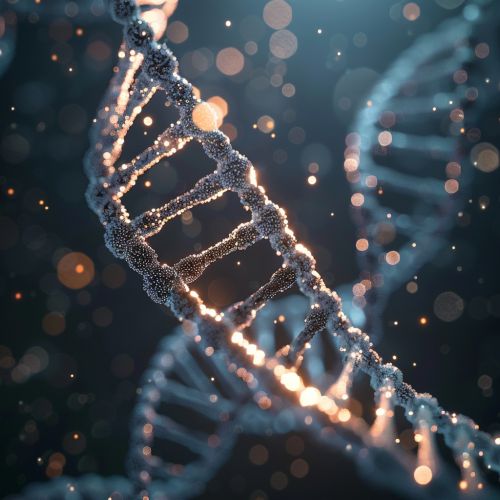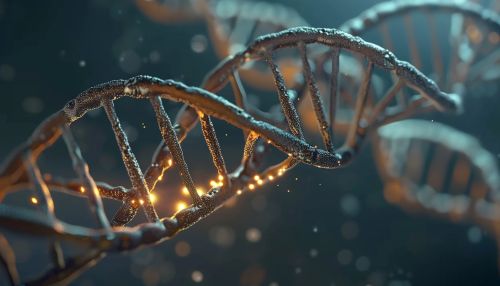Point mutation: Difference between revisions
(Created page with "== Introduction == A Point mutation is a type of mutation that causes a single nucleotide base change, insertion, or deletion of the genetic material, DNA or RNA. The term encompasses a wide variety of mutations, including changes in single base pairs, the insertion of a single base pair, or the deletion of a single base pair. Point mutations can have a variety of effects on the resulting protein produced by transcription and Translatio...") |
No edit summary |
||
| (One intermediate revision by the same user not shown) | |||
| Line 18: | Line 18: | ||
[[Deletion (genetics)|Deletions]] are point mutations where a single base pair is removed from the DNA sequence. Like insertions, deletions can also result in a frameshift if they occur in the coding region of a gene. | [[Deletion (genetics)|Deletions]] are point mutations where a single base pair is removed from the DNA sequence. Like insertions, deletions can also result in a frameshift if they occur in the coding region of a gene. | ||
[[Image:Detail-77919.jpg|thumb|center|A close-up view of a DNA double helix with a point mutation highlighted.|class=only_on_mobile]] | |||
[[Image:Detail-77920.jpg|thumb|center|A close-up view of a DNA double helix with a point mutation highlighted.|class=only_on_desktop]] | |||
== Effects of Point Mutations == | == Effects of Point Mutations == | ||
Latest revision as of 11:22, 8 May 2024
Introduction
A Point mutation is a type of mutation that causes a single nucleotide base change, insertion, or deletion of the genetic material, DNA or RNA. The term encompasses a wide variety of mutations, including changes in single base pairs, the insertion of a single base pair, or the deletion of a single base pair. Point mutations can have a variety of effects on the resulting protein produced by transcription and translation of the genetic material.
Types of Point Mutations
There are several types of point mutations, including base substitutions, insertions, and deletions.
Base Substitutions
Base substitutions are the simplest type of point mutation, occurring when one base pair is replaced by another. These can be further classified into two types: transitions and transversions.
Transitions are a type of base substitution where a purine base is replaced by another purine or a pyrimidine is replaced by another pyrimidine. For example, a change from adenine (A) to guanine (G) would be a transition.
Transversions are a type of base substitution where a purine is replaced by a pyrimidine, or vice versa. For example, a change from adenine (A) to thymine (T) would be a transversion.
Insertions
Insertions are point mutations where a single base pair is inserted into the DNA sequence. This can result in a frameshift if it occurs in the coding region of a gene.
Deletions
Deletions are point mutations where a single base pair is removed from the DNA sequence. Like insertions, deletions can also result in a frameshift if they occur in the coding region of a gene.


Effects of Point Mutations
Point mutations can have a variety of effects on the resulting protein, ranging from no effect at all to the creation of a completely different protein.
Silent Mutations
Silent mutations are point mutations that do not result in a change to the amino acid sequence of a protein. This is because the genetic code is degenerate, meaning that multiple codons can code for the same amino acid.
Missense Mutations
Missense mutations are point mutations that result in a different amino acid being incorporated into the resulting protein. This can have a variety of effects, depending on the nature of the change. Some changes may have little to no effect on the protein's function, while others can render the protein nonfunctional.
Nonsense Mutations
Nonsense mutations are point mutations that result in a premature stop codon. This results in a truncated protein, which is often nonfunctional.
Frameshift Mutations
Frameshift mutations are a type of point mutation that can occur as a result of insertions or deletions. These mutations shift the reading frame of the gene, which can result in a completely different amino acid sequence from the point of mutation onwards.
Causes of Point Mutations
Point mutations can be caused by a variety of factors, including errors during DNA replication, exposure to mutagens, or the activity of transposable elements.
Errors During DNA Replication
Errors during DNA replication can result in point mutations. DNA polymerase, the enzyme responsible for replicating DNA, has proofreading activity and can correct most errors. However, some errors may escape this proofreading, resulting in a point mutation.
Exposure to Mutagens
Exposure to mutagens, substances or environmental factors that can cause mutations, can also result in point mutations. These can include chemicals, radiation, and certain viruses.
Transposable Elements
Transposable elements, also known as "jumping genes", can cause point mutations. These pieces of DNA can move around the genome and insert themselves into genes, potentially causing a point mutation.
Detection and Analysis of Point Mutations
Various techniques are available for the detection and analysis of point mutations. These include DNA sequencing, allele-specific oligonucleotide (ASO) probes, and the use of restriction fragment length polymorphisms (RFLPs).
DNA Sequencing
DNA sequencing is the most direct method for detecting point mutations. This technique determines the exact order of the bases in a DNA molecule, allowing for the identification of any base changes.
Allele-Specific Oligonucleotide Probes
Allele-specific oligonucleotide (ASO) probes can be used to detect specific point mutations. These short pieces of DNA are designed to bind to a specific sequence, and can be used to detect the presence or absence of a specific point mutation.
Restriction Fragment Length Polymorphisms
Restriction fragment length polymorphisms (RFLPs) can also be used to detect point mutations. If a point mutation creates or destroys a restriction enzyme cut site, this can be detected by looking at the size of the resulting DNA fragments after digestion with the restriction enzyme.
See Also
- Mutation
- DNA replication
- Transcription (genetics)
- Translation (biology)
- Base substitution
- Transition (genetics)
- Transversion
- Insertion (genetics)
- Deletion (genetics)
- Silent mutation
- Missense mutation
- Nonsense mutation
- Frameshift mutation
- Mutagen
- Transposable element
- DNA sequencing
- Allele-specific oligonucleotide
- Restriction fragment length polymorphism
